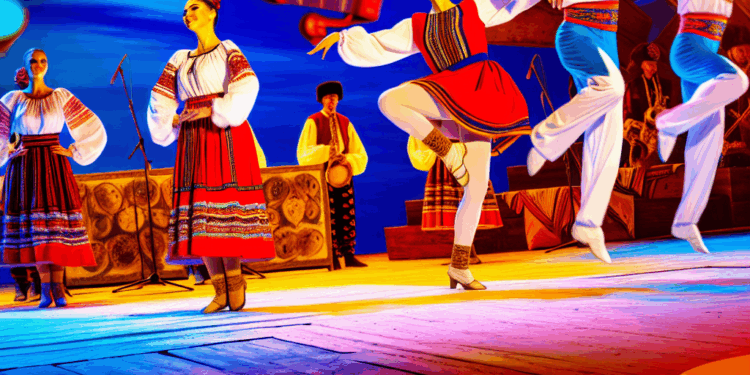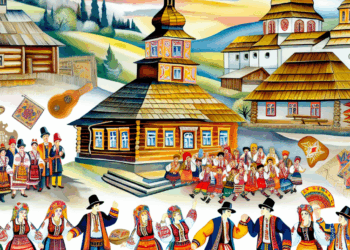Introduction
Bukovyna is a unique corner of Eastern Europe, located at the crossroads of Ukrainian, Romanian, Jewish and Polish cultures. Its rich history, a land of diverse customs, traditions and crafts, attracts the attention of researchers, tourists and culture lovers. Despite political changes, this multi-ethnic heritage continues to live on in the hearts and minds of those who call Bukovina their home.
Historical context
The first mention of Bukovina dates back to the 13th century, when the territory was part of the principality of Galicia-Volhynia and later fell under the influence of the Ottoman Empire and the Austro-Hungarian Empire. In the XIX century, due to its geographical position, the regions began to develop actively, which favoured the mixing of cultures. Both Ukrainians, Romanians, Poles, Jews and other ethnic groups lived in Bukovina, resulting in a unique cultural mosaic.
Traditions and rituals
Celebrations
One of the most important holidays in Bukovina is the January Fair, dedicated to the traditions and customs of the New Year. At the fair you can see folk costumes, hear music by local performers and buy handicrafts by folk artisans. Also popular are the Koliads – winter festivals accompanied by carols and dances.
The Trinity festival is no less important, with offerings and rituals in the fresh meadows and families gathering for meals together. Trinity rituals include decorating houses with green branches and flowers, symbolising renewal and vitality.
Customs
Bukovina has preserved many customs related to the human life cycle – birth, wedding and death. For example, at weddings there is traditionally held the rite of vinshuvannya – special congratulations and good wishes from relatives and friends of the newlyweds.
Folk costumes
Folk costumes of Bukovina are a vivid manifestation of local culture. Each ethnic group has its own peculiarities in clothing, but they also intertwine and mutually influence each other.
Ukrainian costume
Traditional Ukrainian costume in Bukovina usually includes a shirt decorated with embroidery and a skirt or trousers. Women are characterised by long skirts and warm shawls, while men wear shirts with embroidery on the collars.
Romanian costume
Romanian folk costume is characterised by puffy skirts and brightly coloured belts. Women often wear aprons and men wear hats and leather shoes.
Jewish and Polish costumes
Jews are characterised by kdeshim (traditional Jewish costumes), which symbolises their faith and identity. Polish costumes are notable for their variety of fabrics and patterns. Particularly popular are costumes decorated with national symbols.
All these costumes, in addition to their artistic features, include specific elements that testify to the differences and interactions of cultures.
Crafts
Craft skills
Bukovina is famous for its handicrafts, among which vine weaving, pottery, wood carving and embroidery stand out. Many craftsmen continue family traditions, passing their skills from generation to generation.
Vine weaving
Vine weaving is one of the oldest crafts in the region. Vines are used to make baskets, furniture and decorative elements. Masters such as Igor Kovalev from the village of Rososha create amazing products that are popular with locals and tourists alike.
Pottery
Pottery in Bukovina has a long history. Masters such as Fyodor Shevchuk from Kosov village produce ceramic utensils that are characterised by their style and high quality.
Music and folklore
Music
The music of Bukovina is a reflection of the diversity of cultural influences. At traditional festivals one can hear folk melodies played on the kobza, trembita and other instruments.
One of the most famous musical groups is the Bukovinski Musiki, who perform both Ukrainian and Romanian folk songs. The music is often accompanied by dances, such as gopak and the dance of the Rumanian chobits.
Folklore
The folklore of Bukovina is replete with songs, tales and legends. For example, legends about Transcarpathia, legends of love and loss, are often the subjects of many songs. Stories about local heroes and history continue to live on in the oral tradition.
Influence of multinationality
One of the most beautiful features of Bukovina is its multinationality. Ukrainian, Romanian, Jewish and Polish cultures merge here, enriching each other.
Ukrainian culture
Ukrainian culture is significantly manifested in folk music, dances and customs. Traditions, such as kupala, are celebrated with special fervour. It is a time for bright colours, bonfires and fellowship, which symbolises unity and love.
Romanian culture
Romanian culture is represented in festivals, rituals and national music. Many Romanian compositions have been adapted to Polish melodies, creating unique syntheses.
Jewish culture
The Jewish community has contributed to the cultural heritage of the region. Traditions associated with holidays such as Passover and Hanukkah enrich local rituals. Local Jewish melodies are also used in the music of other cultures.
Polish culture
Polish culture is most prominent in architecture and cuisine. Many Polish dishes have been adapted by the locals, which has also enriched the gastronomic palette of the region.
Conclusion
The culture of Bukovina is a lively and diverse kaleidoscope of traditions, rituals and arts, in which different nations and ethnicities are intertwined. The multinational heritage continues, acquiring new forms and directions. A study of this unique region will help to better understand not only its cultural richness, but also how history shapes the individuality and unity of peoples.
Thus, Bukovyna remains not only a witness of historical changes, but also an important part of Ukraine, preserving the diversity and uniqueness that makes it a true cultural heritage of Europe.








